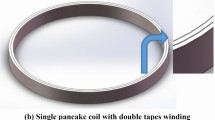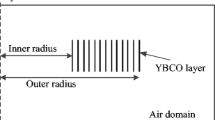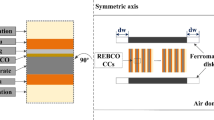Abstract
High-temperature superconducting (HTS) coils are key parts of many large-scale AC applications, such as transformers, superconducting magnetic energy storage, and motors. The estimation of AC losses of pancake coils is necessary for optimizing the design of HTS devices and cryogenic systems. To speed up the computation of AC losses, the numerical model of an infinitely long HTS stack is often utilized. An HTS stack is a good approximation of the circular coil only if the coil radius is sufficiently large, since AC losses will exhibit a stronger asymmetry along the radial direction for small values of coil radii. To assess the validation of an infinitely long stack approximation, the comparisons of AC losses between infinitely long stacks and circular coils with different radii are presented. The turn number varies from 10 to 80. We find that the AC losses of HTS circular coils will gradually increase to the same value as an infinitely long stack with increasing coil radii. A new parameter is proposed to quantitatively describe the correctness of infinitely long stack approximation. Finally, a method of AC loss estimation of HTS pancake coils is proposed.
Similar content being viewed by others
Avoid common mistakes on your manuscript.
1 Introduction
High-temperature superconducting (HTS) coated conductors are commercial available nowadays, and HTS coils have drawn extensive attention of large-scale applications, such as transformers, superconducting fault current limiters, and motors [1,2,3,4]. The prediction of AC losses of HTS coils is necessary for optimal designs of these devices. The finite element model (FEM) is generally used to analyze the electromagnetic characteristics of HTS coils. Among various numerical methods, the FEM based on H formulation draws a lot of popularity [5,6,7,8]. The two-dimensional (2-D) axial symmetrical model fully accords with the real geometry of a circular pancake coil, which can accurately estimate the electromagnetic characteristics inside the coil [6, 7, 9]. The HTS infinitely long stack will be a good approximation of circular coils if the coil radius is sufficiently large. The symmetry of the stack model indicates that only one fourth of the model needs to be calculated, which can speed up the computation of AC losses. Therefore, an infinitely long stack model has also been utilized to calculate the AC loss of HTS coils [5, 10,11,12].
Until now, few studies have been carried out on the coil radius over which the AC losses of HTS circular coils can be well described by the stack model [13]. To clarify the validation of infinitely long stack approximation, a systematical comparison of AC losses of the stack model and the axial symmetric model is needed. This paper compares the transport AC losses of both the infinitely long stack and circular pancake coils with different radii by use of the FEM simulation based on H formulation. A new parameter called “critical radius” is defined to quantitatively assess the applicable cases of an infinitely long stack model. Besides, a method of AC loss estimation of HTS pancake coils is proposed.
2 The Finite Element Model
The FEM is based on H formulation and E-J power law, which is implemented in the COMSOL Multiphysics [14]. Both infinitely long stack model [5] and axisymmetric model [9] are established by use of the magnetic-field-formulation interface, as shown in Fig. 1. The numerical model has been validated in our previous works [15,16,17]. In order to reduce the computation time of the problem, only half of the geometry for the 2-D axisymmetric model and one quarter of the geometry for the infinitely long stack model have been calculated based on the model symmetry. For the 2-D axisymmetric model, the bottom boundary condition along the r-axis is Hr = 0. For the infinitely long stack model, the left boundary condition along the y-axis is Hy = 0, and the bottom boundary condition along the x-axis is Hx = 0. The turn numbers of HTS coils are assumed to be 10, 20, 40, and 80, respectively, and the coil radii change from 0 to 100 mm.
Rectangular-mapped meshes and free triangular meshes are employed in the HTS tapes and air region, respectively. For YBCO tapes, there are 80 elements along the tape width and a total of 9 elements across the tape thickness (2 elements in copper layers on either side, 3 elements in substrate, 1 element in the YBCO layer, and 1 element in the Ag layer), which are shown in Fig. 2.
In the FEM simulation, we use the real dimensions of Superpower SCS4050 tapes, which are composed of a YBCO layer, a silver overlayer, a hastelloy substrate, and copper stabilizers on both sides, as shown in the inset of Fig. 1b. The geometric and electrical parameters of the tape are shown in Table 1. The self-field critical current of the YBCO tape at liquid nitrogen temperature is 103.5 A. The resistivity of the YBCO layer is non-linear and can be expressed by a power-law relation
where EC = 1 μ V/cm is the electrical field criterion for the critical current; n is the power-law exponent; JC(B) is the critical current density under a magnetic field, which can be calculated by JC(B) = IC(B)/(hSC ×wtape); and IC(B) is the critical current of the tape under an external field, which can be described by the Kim model as [20]
where k, B0, and α are the anisotropic parameters of critical current and B∥ and B⊥ are magnetic field components parallel and perpendicular to the wide surface of the tape, respectively. The field dependence of normalized critical current iC(iC = IC(B)/IC) for the experimental tape at 77 K is shown in Fig. 3, where data shown by symbols are measured data and the solid lines are calculated from (2) using the parameters k = 1.736, B0 = 0.0809, and α = 0.451. A good agreement between experimental results and calculated values is obtained.
3 Results and Discussion
3.1 Influence of Pancake Coil Radii on AC Losses
Assuming that the applied current is I(t) = Ip sin(ωt), the peak current, Ip, applied to the HTS tapes increases from 10 to 60 A. The AC losses of the infinitely long stack are calculated firstly and used as reference, as shown in Fig. 4. It is found that the average AC losses per unit length increase with the tapes’ number. For the case of the 10-tape stack, the losses are 5.02 × 10− 4 J/cycle/m at Ip = 40 A, which is four times lower than the losses of the 80-tape stack with the same transport current.
In order to investigate the effect of coil radii on AC losses, we calculated the AC losses of the HTS single-pancake (SP) coils with an inner radius changing from 0 to 100 mm. The calculated results for HTS coils with 40 turns are shown in Fig. 5, in which AC losses of HTS coils are normalized by those of an infinitely long stack. It is found that the AC losses of HTS coils are much lower than those of an infinitely long stack for small inner radii. With the increase of the inner radius, the AC losses of HTS coils gradually increase to the same value as an infinitely long stack.
To clarify the reason for lower AC losses of circular coils with small inner radii, the AC losses per turn for the case of 40-turn coils with different radii are shown in Fig. 6. Here, we define the turns of HTS coils (HTS stack) from the innermost (upmost) turn to the outermost (downmost) turn as 1st, 2nd, …, 40th turn. The losses per turn in the HTS coil are normalized by the average loss of the coil. We find that for lower inner radii of HTS coils, the losses per turn exhibit a strong asymmetry along the coil radial direction, and the losses of inner turns are much lower than the average loss. This is because when the coil radius is relatively small, the perpendicular magnetic fields in inner turns are partly cancelled by the other half of the circular coil, as shown in Fig. 7. The perpendicular fields of the HTS coil with low radius are lower than that of an infinitely long stack, and the AC losses of the HTS coils are thus reduced. With the increase of coil radii, the AC losses per turn exhibit weaker asymmetry along the radial direction and gradually approach the loss curve of an infinitely long stack.
3.2 A New Parameter to Assess the Validation of Infinitely Long Stack Approximation
The normalized ratios of average AC losses in circular coils with different turns to those in an infinitely long stack at Ip = 30 A are shown in Fig. 8. It is found that at lower inner radii, the larger the coil turn is, the larger the normalized ratio is. This indicates that the influence of coil radii on the AC losses become less noticeable for HTS coils with larger turns. The normalized ratios for HTS coils with different turns increase to nearly the same value for inner radii larger than 10 mm. It indicates that the influence of the coil turns on the AC losses can be negligible for HTS coils with larger radii.
To assess the validation of infinitely long stack approximation, we propose a new parameter, RC, a critical radius above which the ratio of AC losses of HTS coils to the infinitely long stack is larger than 0.90. That is to say, when the coil radius is larger than the critical radius, the infinitely long stack approximation will overestimate the AC losses of actual circular coil by a maximum percentage of 10%. For the case of the 40-turn circular coil, RC = 9.6 mm, as shown in Fig. 5. The critical radii for SP coils with different turns (N = 10, 20, 40, and 80) are calculated and listed in Table 2. It is shown that the critical radius of the 10-turn coil is 9.0 mm, and it slightly increases with the turn number. Since the minimum bending diameters for most commercial available YBCO-coated conductors are larger than 25 mm, the infinitely long stack approximation is adequate for HTS SP coils.
The critical radii of double pancakes and four pancakes are also obtained by FEM simulation. The normalized ratios of AC losses at peak current 10 A are shown in Fig. 9. It is found that the critical radii for single, double, and four pancakes are 9.6, 19, and 39 mm, respectively. It indicates that the critical radii increase linearly with the number of pancakes and can be described by
where Np is the number of pancakes. It is worth noting that (3) holds only for YBCO coils wound from 4-mm tapes. For YBCO tapes with other widths, however, the value of RC may be different.
3.3 The AC Loss Estimation of HTS Pancake Coils
The estimation of AC losses of HTS pancake coils is important for optimizing the design of HTS devices and the cryogenic system. The AC losses of the HTS stack corresponding to the case of SP coils as a function of stacked-tapes number for different applied currents are shown in Fig. 10. The average AC loss \(P_{\text {avg\_stack}} \) for tape number N and peak current Ip can be obtained by interpolating the AC loss data in Fig. 10. As mentioned above, the AC losses of HTS pancake coils with coil radii larger than RC can be well approximated by an infinitely long stack. Therefore, the AC losses of HTS pancake coils with coil radii larger than RC can be easily calculated by
where \(P_{\text {avg\_stack}} \) is the average loss per cycle calculated by the stack model, ri is the radius of the i th turn, and Pcoil is the AC loss of HTS pancake coils with a turn number of N.
It is found from Fig. 4 that the average AC losses of the HTS stack increase with the increasing turn number. When the coil radii are larger than RC, HTS pancake coils exhibit nearly the same average loss as the HTS stack. For HTS pancake coils with the same total length, the larger the coil radii are, the less turns of HTS coils are. Therefore, the total AC losses of HTS coils with the same total length will decrease with increasing coil radii. These findings are helpful for reducing AC losses of HTS coils.
4 Conclusions
A comparison of AC losses of HTS pancake coils and infinitely long stack has been presented using an axisymmetric model and an infinitely long stack model, respectively. The FEM model is based on H formulation and implemented in COMSOL Multiphysics. The influence of coil radii on AC losses of SP coils with different turns (N = 10, 20, 40, and 80) is investigated. It is found that the AC losses of HTS coils will gradually increase to the same value as an infinitely long stack with increasing coil radii. We propose a new parameter, RC, above which the ratio of AC losses of HTS coils to the infinitely long stack is larger than 0.90, to assess the validation of infinitely long stack approximation. It is found that the critical radius of a 10-turn SP coil is 9.0 mm, and it slightly increases with increasing turn number. Taking the minimum bending diameters of commercial available YBCO-coated conductors with 4-mm width into account, the infinitely long stack approximation is adequate for HTS SP coils. Besides, the critical radii increase linearly with the number of pancakes. Finally, a method of AC loss estimation of HTS pancake coils is proposed, which can be used for the optimal design of practical HTS devices.
References
Pardo, E. et al.: Ac loss modelling and measurement of superconducting transformers with coated-conductor Roebel-cable in low-voltage winding. Supercond. Sci. Technol. 28(11), 114008 (2015)
Liang, F. et al.: Experimental test of two types of non-inductive solenoidal coils for superconducting fault current limiters use. IEEE Trans. Appl. Supercond. 27(4), 1–5 (2017)
Ainslie, M. et al.: Numerical analysis and finite element modelling of an HTS synchronous motor. Physica C: Superconductivity 470(20), 1752–1755 (2010)
Xing, D. et al.: AC loss comparison between multifilament and nonstriated YBCO coils designed for HTS propulsion motors. IEEE Trans. Appl. Supercond. 27(4), 1–5 (2017)
Ainslie, M. D. et al.: An improved FEM model for computing transport AC loss in coils made of RABiTS YBCO coated conductors for electric machines. Supercond. Sci. Technol. 24(4), 045005 (2011)
Zhang, M. et al.: Experimental and numerical study of a YBCO pancake coil with a magnetic substrate. Supercond. Sci. Technol. 25(12), 125020 (2012)
Wang, L. et al.: Numerical simulation of AC loss in 2G high-temperature superconducting coils with 2D-axisymmetric finite element model by magnetic field formulation module. J. Supercond. Nov. Magn. 29(8), 2011–2018 (2016)
Brambilla, R., Grilli, F., Martini, L.: Development of an edge-element model for AC loss computation of high-temperature superconductors. Supercond. Sci. Technol. 20(1), 16 (2007)
Zhang, M. et al.: Study of second generation, high-temperature superconducting coils: determination of critical current. J. Appl. Phys. 111(8), 083902 (2012)
Ainslie, M. D., Flack, T. J., Campbell, A. M.: Calculating transport AC losses in stacks of high temperature superconductor coated conductors with magnetic substrates using FEM. Physica C-Superconductivity and Its Applications 472(1), 50–56 (2012)
Yuan, W., Campbell, A. M., Coombs, T. A.: Ac losses and field and current density distribution during a full cycle of a stack of superconducting tapes. J. Appl. Phys. 107(9), 093909 (2010)
de Bruyn, B. J. H., Jansen, J. W., Lomonova, E. A.: Finite element model simplification methods for stacks of superconducting tapes. IEEE Trans. Magn. 52(7), 1–4 (2016)
Yuan, W. et al.: Comparison of AC losses, magnetic field/current distributions and critical currents of superconducting circular pancake coils and infinitely long stacks using coated conductors. Supercond. Sci. Technol. 23(8), 085011 (2010)
COMSOL, http://www.comsol.com
Liu, G. et al.: Influence of substrate magnetism on frequency-dependent transport loss in HTS-coated conductors. IEEE Trans. Appl. Supercond. 27(8), 1–7 (2017)
Liu, G. et al.: Experimental and numerical study of frequency-dependent transport loss in YBa2Cu3O7–δ coated conductors with ferromagnetic substrate and copper stabilizer. J. Appl. Phys. 121(24), 243902 (2017)
Liu, G. et al.: Numerical study on AC loss reduction of stacked HTS tapes by optimal design of flux diverter. Supercond. Sci. Technol. 30(12), 125014 (2017)
Weast, R. C.: CRC Handbook of Chemistry and Physics, p 1438. CRC Press, Inc, Boca Raton (2001)
Lu, J., Choi, E., Zhou, H.: Physical properties of HastelloyⓇ C-276™ at cryogenic temperatures. J. Appl. Phys. 103(6), 064908 (2008)
Kim, Y., Hempstead, C., Strnad, A.: Critical persistent currents in hard superconductors. Phys. Rev. Lett. 9(7), 306 (1962)
Acknowledgements
The authors would like to acknowledge Dr. Hui Yu for her help in reading this manuscript and for providing valuable comments.
Funding
This work was supported in part by the National Natural Science Foundation of China under Grant 51677180 and in part by the Key Research Program of Frontier Science of the Chinese Academy of Sciences under Grant QYZDJ-SSW-JSC025.
Author information
Authors and Affiliations
Corresponding author
Rights and permissions
About this article
Cite this article
Liu, G., Zhang, G., Jing, L. et al. Comparison of AC Losses of YBCO Circular Pancake Coils and Infinitely Long Stack Approximation. J Supercond Nov Magn 31, 3141–3146 (2018). https://doi.org/10.1007/s10948-018-4576-0
Received:
Accepted:
Published:
Issue Date:
DOI: https://doi.org/10.1007/s10948-018-4576-0














